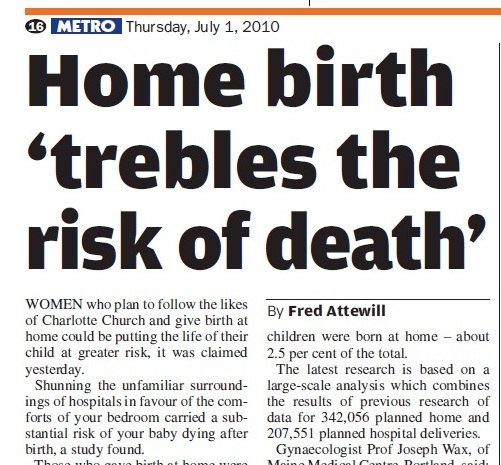Home births unjustly maligned
Earlier this month, lots of media attention was paid to a new analysis concluding that giving birth at home tripled the chances of the baby dying.
“Home Birth Trebles the risk of death” was Metro’s take on the story. “Home birth raises risk for baby, study says” was The Daily Telegraph’s.
Neither reporter can be accused of negligence. That was, indeed, the conclusion reached by a team from Maine, led by Dr Joseph Wax and published in American Journal of Obstetrics and Gynaecology. “Less medical intervention during planned home birth is associated with a tripling of the neonatal mortality rate” was the way the team put it.

But this is an odd study, from which one might as easily have concluded that home births have no effect on the mortality rate at all – for that is also what it found. It depends on whether you look at perinatal deaths, defined as “stillbirth of at least 20 weeks or 500 g or death of liveborn within 28 days of birth” or neonatal deaths, defined as “death of a liveborn within 28 days of delivery”.
The team concluded that neonatal deaths were elevated if mothers opted for a home birth, but perinatal deaths were not.
The odds ratio for perinatal death was 0.95 (excluding babies with abnormalities) with 95 per cent confidence intervals of 0.76 to 1.18. (That is, for perinatal deaths planned home births were marginally safer than planned hospital births, but the result was not statistically significant.) For neonatal deaths the OR was 2.87 (CI 1.32 to 6.25).
The confidence intervals immediately give us a clue what is going on here. While there were a total of 359 deaths of babies without abnormalities that were classified as perinatal, there were only 37 classified as neonatal – hence the very wide confidence intervals. Why did the authors choose to emphasise neonatal deaths, when they had much more evidence on perinatal deaths? Makes a better story, I suppose.
The difference between the definitions of perinatal and neonatal deaths the authors used is small and cannot account for the difference they found. In fact, perinatal is a more inclusive category, as it includes stillbirths. If both neonatal and perinatal deaths are combined, they total 248 deaths in 345,957 planned home births (0.072 per cent) and 148 deaths in 205,265 planned hospital births (0.072 per cent). Not much to shout about there.
The study was a meta-analysis in which the authors had searched the medical literature for papers and combined them in order to produce a more robust outcome. Most of the studies simply hadn’t used the term neonatal at all, preferring the more common term perinatal.
The press release emphasised the size of the study, a common tactic for sedating the unwary: “342,000 planned home births and 207,551 planned hospital births” it said. But only 5 per cent of these births were in studies that used neonatal deaths as a measure, and very low numbers of deaths were recorded in this category.
You cannot draw reliable conclusions from such low numbers. The team responsible acknowledges the “apparent discordance” between the neonatal and perinatal odds ratios, but waves it away by saying that home births have later gestational ages at delivery and greater birthweights, and that once corrected for this factor, the standardised perinatal mortality ratio for homebirths would be higher.
This amounts to saying that, on average, home births are lower-risk pregnancies – or else they would be taking place in hospital – and ought to have better results than planned hospital births, rather than equally good.
It’s a point of view, but actually it is irrelevant to the individual mother. Adjusting risk for confounding factors is a purely academic exercise for her. Her choice is based on what her own risk is perceived to be, not on what it might be if corrected for confounding factors. And looking at the raw data, she can see that the overall risks for her baby of planned home birth are identical with those for planned hospital birth. As for herself, the risks of infection are much lower, and so is the likelihood of medical intervention during birth, important to some women.
The National Childbirth Trust has criticised other aspects of the analysis (file attached below), including the choice of studies included and excluded, and the possible misclassification of deaths within those studies. It concludes that the authors are completely unjustified in claiming that “less medical intervention during planned home birth is associated with a tripling of the neonatal mortality rate”.
“On the basis of the poor quality of their data the authors should not have reached this conclusion. Furthermore, the editors of the American Journal of Obstetrics and Gynaecology should not have accepted the paper for publication without major modifications” says the NCT.
Best ignored, then.



